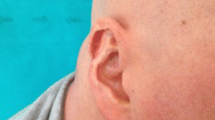Abstract
Objective
We hypothesize that imaging findings from CT and MRI correlate better with clinical markers for assessment of disease activity in patients with the rare relapsing polychondritis (RPC) than with serological inflammatory markers.
Materials and methods
Retrospective database search at our institution identified 28 patients (13 females; age 49.0 years ± 15.0 SD) with RP between September 2004 and March 2014. Institutional review board approval was obtained for this retrospective data analysis. All patients had clinically proven RPC with at least two episodes of active disease. Of those, 18 patients were examined with CT- and MRI and presented all morphologic features of RPC like bronchial/laryngeal/auricular cartilage thickness, contrast enhancement, increased T2-signal intensity. Imaging data was subsequently correlated with corresponding clinical symptoms like fever, dyspnea, stridor, uveitis, pain, hearing impairment as well as with acute-phase-inflammatory parameters like C-reactive protein (CRP) and erythrocyte sedimentation rate (ESR).
Results
The clinical parameters were in good agreement with imaging findings and clinical symptoms such as tracheal wall thickening and dyspnea (r =0.65 p = 0.05), joint synovitis on MRI and a higher McAdam score (r = 0.84 p < 0.001). No correlations were found between inflammatory laboratory markers, imaging findings and clinical features.
Conclusion
Imaging diagnosis in RPC using CT and/or MRI delivers information about the degree of disease activity that correlates better with clinical features than unspecific inflammatory laboratory markers. Additionally, clinically unapparent cartilage involvement can be assessed adding value to the clinical diagnosis and therapy planning in this rare disease.




Similar content being viewed by others
References
Badireddi S, Siddiqui MF, Boddu NJ. Respiratory failure secondary to relapsing polychondritis. Respir Care. 2014;59(9):e140–143.
Bayer G, Diot E, Erra B. Utility of 18F-FDG PET/CT in relapsing polychondritis. QJM. 2014;108(4):339–40.
Yamashita H, Takahashi H, Kubota K, Ueda Y, Ozaki T, Yorifuji H, et al. Utility of fluorodeoxyglucose positron emission tomography/computed tomography for early diagnosis and evaluation of disease activity of relapsing polychondritis: a case series and literature review. Rheumatology (Oxford, England). 2014;53(8):1482–90.
Gautier M, Boutemy J, Ivascau C, Galateau-Salle F, Labombarda F. Cardiac involvement in relapsing polychondritis. Eur Heart J. 2014;35(33):2241.
Chopra R, Chaudhary N, Kay J. Relapsing polychondritis. Rheum Dis Clin N Am. 2013;39(2):263–76.
Sinha N, Gallant C, Walsh NM. A case of red ears: relapsing polychondritis. Am J Dermatopathol. 2014;36(2):158–9. 184–155.
Wang J, Li S, Zeng Y, Chen P, Zhang N, Zhong N. (1)(8)F-FDG PET/CT is a valuable tool for relapsing polychondritis diagnose and therapeutic response monitoring. Ann Nucl Med. 2014;28(3):276–84.
Wortsman X, Jemec GB. Sonography of the ear pinna. J Ultrasound Med. 2008;27(5):761–70.
Jotz GP, Stefani MA, Pereira da Costa Filho O, Malysz T, Soster PR, Leao HZ. A morphometric study of the larynx. J Voice. 2014;28(6):668–72.
Prasad A, Yu E, Wong DT, Karkhanis R, Gullane P, Chan VW. Comparison of sonography and computed tomography as imaging tools for assessment of airway structures. J Ultrasound Med. 2011;30(7):965–72.
Shin HW, Ahn Y, Sung MW, Kim KH, Kwon TK. Measurement of cross-sectional dimensions of the cricoid cartilage: a computed tomographic study. Ann Otol Rhinol Laryngol. 2009;118(4):253–8.
Tiddens H, Silverman M, Bush A. The role of inflammation in airway disease: remodeling. Am J Respir Crit Care Med. 2000;162(2 Pt 2):S7–s10.
Webb EM, Elicker BM, Webb WR. Using CT to diagnose nonneoplastic tracheal abnormalities: appearance of the tracheal wall. AJR Am J Roentgenol. 2000;174(5):1315–21.
Xie X, Dijkstra AE, Vonk JM, Oudkerk M, Vliegenthart R, Groen HJ. Chronic respiratory symptoms associated with airway wall thickening measured by thin-slice low-dose CT. AJR Am J Roentgenol. 2014;203(4):W383–390.
Kuwabara M, Shimono T, Toyomasu M, Shioyama M, Mitsui Y, Yoshinaga E, et al. “Prominent ear sign” on diffusion-weighted magnetic resonance imaging in relapsing polychondritis. Radiat Med. 2008;26(7):438–41.
Pickford HA, Swensen SJ, Utz JP. Thoracic cross-sectional imaging of amyloidosis. AJR Am J Roentgenol. 1997;168(2):351–5.
Mariotta S, Pallone G, Pedicelli G, Bisetti A. Spiral CT and endoscopic findings in a case of tracheobronchopathia osteochondroplastica. J Comput Assist Tomogr. 1997;21(3):418–20.
Quercetani R, Gelli R, Pimpinelli N, Reali UM. Bilateral chondroma of the auricle. J Dermatol Surg Oncol. 1988;14(4):436–8.
McAdam LP, O’Hanlan MA, Bluestone R, Pearson CM. Relapsing polychondritis: prospective study of 23 patients and a review of the literature. Medicine. 1976;55(3):193–215.
Loricera J, Blanco R, Castaneda S, Humbria A, Ortego-Centeno N, Narvaez J, et al. Tocilizumab in refractory aortitis: study on 16 patients and literature review. Clin Exp Rheumatol. 2014;32(3 Suppl 82):S79–89.
Mahida RY, Bowman S, Naidu B, Thickett DR. Positron emission tomography aids diagnosis of relapsing polychondritis. BMJ Case Rep. 2014. doi:10.1136/bcr-2013-203367.
Sato M, Hiyama T, Abe T, Ito Y, Yamaguchi S, Uchiumi K, et al. F-18 FDG PET/CT in relapsing polychondritis. Ann Nucl Med. 2010;24(9):687–90.
De Geeter F. Nuclear imaging in relapsing polychondritis. J Clinical Rheumatol. 2013;19(2):55–6.
Author information
Authors and Affiliations
Corresponding author
Ethics declarations
Conflict of interest
The authors declare that they have no conflict of interest.
Rights and permissions
About this article
Cite this article
Thaiss, W.M., Nikolaou, K., Spengler, W. et al. Imaging diagnosis in relapsing polychondritis and correlation with clinical and serological data. Skeletal Radiol 45, 339–346 (2016). https://doi.org/10.1007/s00256-015-2270-x
Received:
Revised:
Accepted:
Published:
Issue Date:
DOI: https://doi.org/10.1007/s00256-015-2270-x




